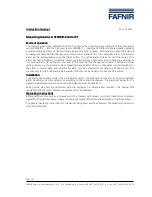
Pre-corrector
The Pre-correction board comprises three separate sections: an input attenuator, a
phase corrector and an output amplifier. The input attenuator is made up of R1 through
R3. The adjustable phase corrector comprises L1, CR1, and R4. U1 is an amplifier IC
and receives power from voltage regulator U2. The amount of correction is controlled by
the adjustment of L1. Typically the adjustment is set to correct for the amount of
differential phase introduced by the PA stages and this should correspond to
approximately unity gain through the Pre-correction board.
Linearity Corrector
The Linearity Corrector board provides a slight amount of linearity correction
needed for intermodulation distortion in the PA stages. R2 and C2 control the amount of
correction by allowing the signal to be shunted to ground by diodes CR1 and CR2. A
higher level signal will cause the diodes to conduct more, shunting more signal to ground.
R3 acts as a fine control by varying the bias on CR1 and CR2 through emitter follower
Q1.
IPA MODULE
CIRCUIT DESCRIPTION
The amplifier consists of two stages of amplification, a linear hybrid IC and a
transistor power stage. Both stages are biased for Class A operation and each has its own
set of three terminal regulators for voltage or current regulation.
The signal is first applied to a form of variable attenuator consisting of R2, R6
and R12. The first stage of amplification is a CA2842 hybrid IC; this amplifier provides
approximately 22dB of gain. A coaxial cable jumper is provided between this stage and
the next to allow for troubleshooting.
The second stage of amplification is a Class A biased MRF325 transistor
amplifier. The input section consists of an attenuator/matching network to transform the
50ohm impedance to values needed for optimum transistor performance. Similarly, a
matching network at the output of the transistor provides the impedance match to the
50ohm
output. C6 and C19 are DC blocking capacitors at the input and output of the
amplifier respectively.
DC power to the hybrid stage is provided by a three terminal voltage regulator IC
(VR1). This serves to remove hum from the power supply as well as provide an
interlocking circuit for other applications. This interlocking function is not used in the
250W amplifier application and thus E2 should have a jumper to ground. The DC power
to the output stage is also provided by a three terminal voltage regulator. VR2 is
configured as a 1.5A constant current source. The current is set by the voltage drop


































